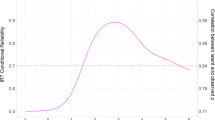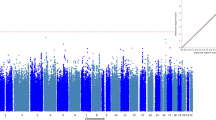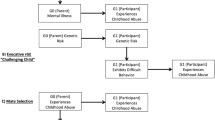Abstract
Recent studies have shown that different mental-health problems appear to be partly influenced by the same set of genes, which can be summarized by a general genetic factor. To date, such studies have relied on surveys of community-based samples, which could introduce potential biases. The goal of this study was to examine whether a general genetic factor would still emerge when based on a different ascertainment method with different biases from previous studies. We targeted all adults in Sweden (n=3 475 112) using national registers and identified those who had received one or more psychiatric diagnoses after seeking or being forced into mental health care. In order to examine the genetic versus environmental etiology of the general factor, we examined whether participants’ full- or half-siblings had also received diagnoses. We focused on eight major psychiatric disorders based on the International Classification of Diseases, including schizophrenia, schizoaffective disorder, bipolar disorder, depression, anxiety, attention-deficit/hyperactivity disorder, alcohol use disorder and drug abuse. In addition, we included convictions of violent crimes. Multivariate analyses demonstrated that a general genetic factor influenced all disorders and convictions of violent crimes, accounting for between 10% (attention-deficit/hyperactivity disorder) and 36% (drug abuse) of the variance of the conditions. Thus, a general genetic factor of psychopathology emerges when based on both surveys as well as national registers, indicating that a set of pleiotropic genes influence a variety of psychiatric disorders.
This is a preview of subscription content, access via your institution
Access options
Subscribe to this journal
Receive 12 print issues and online access
$259.00 per year
only $21.58 per issue
Buy this article
- Purchase on Springer Link
- Instant access to full article PDF
Prices may be subject to local taxes which are calculated during checkout


Similar content being viewed by others
References
American Psychiatric Association Diagnostic and Statistical Manual of Mental Disorders, 5th (edn). American Psychiatric Publishing: Arlington, VA, 2013.
Kessler RC, Ormel J, Petukhova M, McLaughlin KA, Green JG, Russo LJ et al. Development of lifetime comorbidity in the World Health Organization world mental health surveys. Arch Gen Psychiatry 2011; 68: 90–100.
Kessler RC, Chiu WT, Demler O, Merikangas KR, Walters EE . Prevalence, severity, and comorbidity of 12-month DSM-IV disorders in the National Comorbidity Survey Replication. Arch Gen Psychiatry 2005; 62: 617–627.
Krueger RF, Caspi A, Moffitt TE, Silva PA . The structure and stability of common mental disorders (DSM-III-R): a longitudinal-epidemiological study. J Abnorm Psychol 1998; 107: 216–227.
Kendler KS, Aggen SH, Knudsen GP, Roysamb E, Neale MC, Reichborn-Kjennerud T . The structure of genetic and environmental risk factors for syndromal and subsyndromal common DSM-IV axis I and all axis II disorders. Am J Psychiatry 2011; 168: 29–39.
Caspi A, Houts RM, Belsky DW, Goldman-Mellor SJ, Harrington H, Israel S et al. The p factor: one general psychopathology factor in the structure of psychiatric disorders? Clin Psychol Sci 2013; 2: 119–137.
Lahey BB, Applegate B, Hakes JK, Zald DH, Hariri AR, Rathouz PJ . Is there a general factor of prevalent psychopathology during adulthood? J Abnorm Psychol 2012; 121: 971–977.
Lahey BB, Van Hulle CA, Singh AL, Waldman ID, Rathouz PJ . Higher-order genetic and environmental structure of prevalent forms of child and adolescent psychopathology. Arch Gen Psychiatry 2011; 68: 181–189.
Pettersson E, Anckarsater H, Gillberg C, Lichtenstein P . Different neurodevelopmental symptoms have a common genetic etiology. J Child Psychol Psychiatry 2013; 54: 1356–1365.
Tackett JL, Lahey BB, van Hulle C, Waldman I, Krueger RF, Rathouz PJ . Common genetic influences on negative emotionality and a general psychopathology factor in childhood and adolescence. J Abnorm Psychol 2013;.122: 1142–1153.
Galea S, Tracy M . Participation rates in epidemiologic studies. Ann Epidemiol 2007; 17: 643–653.
Kessler RC, Berglund P, Chiu WT, Demler O, Heeringa S, Hiripi E et al. The US National Comorbidity Survey Replication (NCS-R) design and field procedures. Int J Methods Psychiatr Res 2004; 13: 69–92.
Takayanagi Y, Spira AP, Roth KB, Gallo JJ, Eaton WW, Mojtabai R . Accuracy of reports of lifetime mental and physical disorders results from the baltimore epidemiological catchment area study. JAMA Psychiatry 2014; 71: 273–280.
Moffitt TE, Caspi A, Taylor A, Kokaua J, Milne BJ, Polanczyk G et al. How common are common mental disorders? Evidence that lifetime prevalence rates are doubled by prospective versus retrospective ascertainment. Psychol Med 2010; 40: 899–909.
World Health Organization ICD-10: The ICD-10 Classification of Mental and Behavioural Disorders. Geneva, Switzerland, 1992.
Kendler KS, Heath AC, Martin NG, Eaves LJ . Symptoms of anxiety and symptoms of depression - same genes, different environments. Arch Gen Psychiatry 1987; 44: 451–457.
McArdle JJ, Goldsmith HH . Alternative common factor models for multivariate biometric analyses. Behav Genet 1990; 20: 569–608.
Neale MC, Cardon LR . Methodology for Genetic Studies of Twins and Families. Kluwer Academic Publishers: Dordrecht, The Netherlands, 1992.
Franic S, Dolan CV, Borsboom D, Hudziak JJ, van Beijsterveldt CEM, Boomsma DI . Can genetics help psychometrics? Improving dimensionality assessment through genetic factor modeling. Psychol Methods 2013; 18: 406–433.
Kaiser HF . The application of electronic-computers to factor-analysis. Educ Psychol Meas 1960; 20: 141–151.
Horn JL . A rationale and test for the number of factors in factor-analysis. Psychometrika 1965; 30: 179–185.
Cattell RB . Scree test for number of factors. Multivariate Behav Res 1966; 1: 245–276.
Velicer WF . Determining number of components from matrix of partial correlations. Psychometrika 1976; 41: 321–327.
Schmid J, Leiman JM . The development of hierarchical factor solutions. Psychometrika 1957; 22: 53–61.
Muthén LK, Muthén BO . Mplus User's Guide, 7th (edn). Muthén & Muthén: Los Angeles, CA, USA, 1998-2012.
Team RC. R:. A Language and Environment for Statistical Computing, 3.0.1 (edn). R Foundation for Statistical Computing: Vienna, Austria, 2013.
Bernaards CA, Jennrich RI . Gradient projection algorithms and software for arbitrary rotation criteria in factor analysis. Educ Psychol Meas 2005; 65: 676–696.
Revelle W . psych: Procedures for Personality and Psychological Research, Northwestern University, Evanston, Illinois, USA, 2015. http://CRAN.R-project.org/package=psych Version = 1.5.4.
Lichtenstein P, Yip BH, Bjork C, Pawitan Y, Cannon TD, Sullivan PF et al. Common genetic determinants of schizophrenia and bipolar disorder in Swedish families: a population-based study. Lancet 2009; 373: 234–239.
Smoller JW, Craddock N, Kendler K, Lee PH, Neale BM, Nurnberger JI et al. Identification of risk loci with shared effects on five major psychiatric disorders: a genome-wide analysis. Lancet 2013; 381: 1371–1379.
Purcell SM, Wray NR, Stone JL, Visscher PM, O'Donovan MC, Sullivan PF et al. Common polygenic variation contributes to risk of schizophrenia and bipolar disorder. Nature 2009; 460: 748–752.
Hopwood CJ, Malone JC, Ansell EB, Sanislow CA, Grilo CM, McGlashan TH et al. Personality assessment in DSM-5: empirical support for rating severity, style, and traits. J Pers Disord 2011; 25: 305–320.
Lahey BB, Rathouz PJ, Keenan K, Stepp SD, Loeber R, Hipwell AE . Criterion validity of the general factor of psychopathology in a prospective study of girls. J Child Psychol Psychiatry 2015; 56: 415–422.
Rushton JP, Bons TA, Hur YM . The genetics and evolution of the general factor of personality. J Res Pers 2008; 42: 1173–1185.
Tellegen A, Watson D, Clark LA . On the dimensional and hierarchical structure of affect. Psychol Sci 1999; 10: 297–303.
Association AP. Diagnostic and Statistical Manual of Mental Disorders, 4th (edn), text rev. Washington, DC: Author 2000.
Tellegen A, Ben-Porath YS, McNulty JL, Arbisi PA, Graham JR, Kaemmer B . The MMPI-2 Restructured Clinical (RC) Scales: Development, Validation, and Interpretation. University of Minnesota Press: Minneapolis, MN, USA, 2003.
Akaike H . New look at statistical-model identification. IEEE Trans Automat Contr 1974; Ac19: 716–723.
Kendler KS, Maes HH, Sundquist K, Ohlsson H, Sundquist J . Genetic and family and community environmental effects on drug abuse in adolescence: a Swedish national twin and sibling study. Am J Psychiatry 2014; 171: 209–217.
Kendler KS, Aggen SH, Knudsen GP, Roysamb E, Neale MC, Reichborn-Kjennerud T . The structure of genetic and environmental risk factors for syndromal and subsyndromal common DSM-IV axis I and All Axis II disorders. Am J Psychiat 2011; 168: 29–39.
Acknowledgements
This research was funded by National Institute of Health (R01 HD056354-04A1); the Swedish Research Council for Health, Working Life, and Welfare; and the Swedish Research Council. We are grateful to Amir Sariaslan for preparing the data set and to Ralf Kuja-Halkola for valuable contributions to our discussion about shared environment assumptions.
Author information
Authors and Affiliations
Corresponding author
Ethics declarations
Competing interests
The authors declare no conflict of interest.
Additional information
Supplementary Information accompanies the paper on the Molecular Psychiatry website
Supplementary information
PowerPoint slides
Rights and permissions
About this article
Cite this article
Pettersson, E., Larsson, H. & Lichtenstein, P. Common psychiatric disorders share the same genetic origin: a multivariate sibling study of the Swedish population. Mol Psychiatry 21, 717–721 (2016). https://doi.org/10.1038/mp.2015.116
Received:
Revised:
Accepted:
Published:
Issue Date:
DOI: https://doi.org/10.1038/mp.2015.116
This article is cited by
-
Psychosis superspectrum I: Nosology, etiology, and lifespan development
Molecular Psychiatry (2024)
-
Selective mutism and the risk of mental and neurodevelopmental disorders among siblings
European Child & Adolescent Psychiatry (2024)
-
Selecting cases of major psychiatric and substance use disorders in Swedish national registries on the basis of clinical features to maximize the strength or specificity of the genetic risk
Molecular Psychiatry (2023)
-
Overlap between general factors of psychopathology and personality: They share associations with daily life functioning and communication style
Current Psychology (2023)
-
Application of deep learning algorithm on whole genome sequencing data uncovers structural variants associated with multiple mental disorders in African American patients
Molecular Psychiatry (2022)



